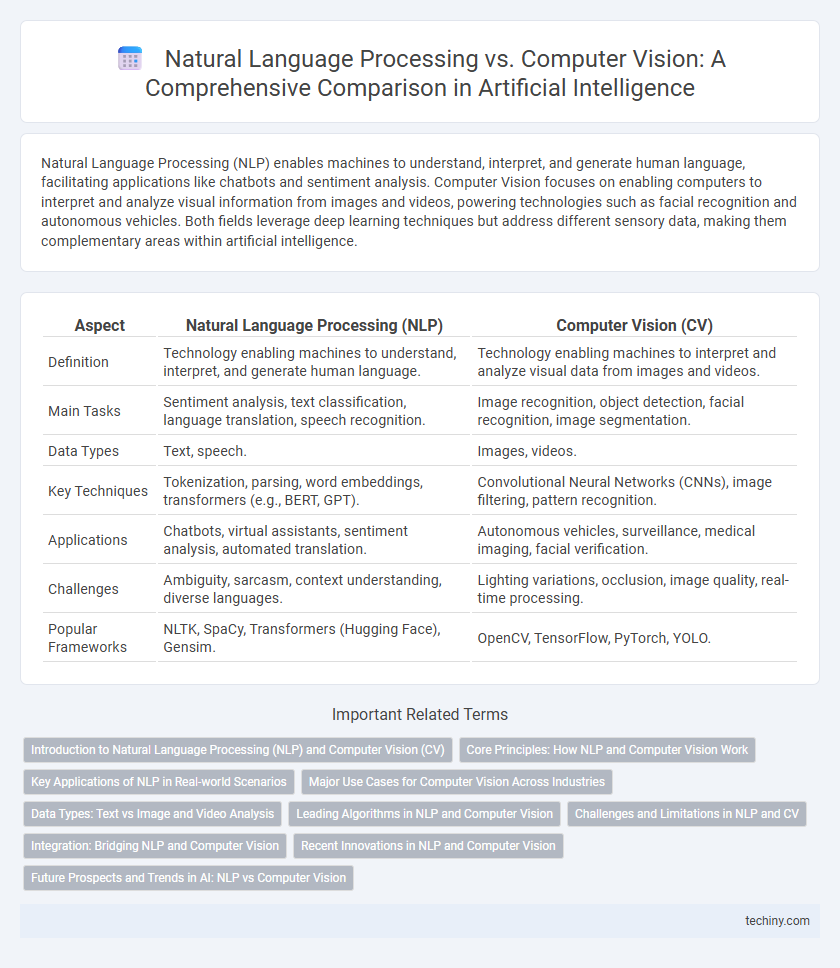Natural Language Processing (NLP) enables machines to understand, interpret, and generate human language, facilitating applications like chatbots and sentiment analysis. Computer Vision focuses on enabling computers to interpret and analyze visual information from images and videos, powering technologies such as facial recognition and autonomous vehicles. Both fields leverage deep learning techniques but address different sensory data, making them complementary areas within artificial intelligence.
Table of Comparison
| Aspect | Natural Language Processing (NLP) | Computer Vision (CV) |
|---|---|---|
| Definition | Technology enabling machines to understand, interpret, and generate human language. | Technology enabling machines to interpret and analyze visual data from images and videos. |
| Main Tasks | Sentiment analysis, text classification, language translation, speech recognition. | Image recognition, object detection, facial recognition, image segmentation. |
| Data Types | Text, speech. | Images, videos. |
| Key Techniques | Tokenization, parsing, word embeddings, transformers (e.g., BERT, GPT). | Convolutional Neural Networks (CNNs), image filtering, pattern recognition. |
| Applications | Chatbots, virtual assistants, sentiment analysis, automated translation. | Autonomous vehicles, surveillance, medical imaging, facial verification. |
| Challenges | Ambiguity, sarcasm, context understanding, diverse languages. | Lighting variations, occlusion, image quality, real-time processing. |
| Popular Frameworks | NLTK, SpaCy, Transformers (Hugging Face), Gensim. | OpenCV, TensorFlow, PyTorch, YOLO. |
Introduction to Natural Language Processing (NLP) and Computer Vision (CV)
Natural Language Processing (NLP) enables machines to understand and generate human language, facilitating applications such as language translation, sentiment analysis, and chatbots. Computer Vision (CV) involves the automated extraction, analysis, and understanding of visual information from images or videos, powering technologies like facial recognition, object detection, and autonomous driving. Both NLP and CV are critical subfields of Artificial Intelligence that transform unstructured data into actionable insights.
Core Principles: How NLP and Computer Vision Work
Natural Language Processing (NLP) relies on linguistic models and deep learning algorithms to analyze, interpret, and generate human language by processing text and speech data. Computer Vision employs convolutional neural networks (CNNs) and image processing techniques to identify patterns, objects, and spatial relationships within visual inputs. Both fields utilize machine learning frameworks but differ fundamentally in handling sequential language data versus pixel-based image data.
Key Applications of NLP in Real-world Scenarios
Natural Language Processing (NLP) excels in applications such as sentiment analysis, machine translation, chatbots, and automated summarization, enabling machines to interpret and generate human language effectively. Its deployment in virtual customer assistants and voice-activated systems enhances user interaction across industries like healthcare, finance, and e-commerce. Unlike Computer Vision, which centers on image and video analysis, NLP primarily processes textual and auditory data to extract meaningful insights and support decision-making.
Major Use Cases for Computer Vision Across Industries
Computer Vision drives innovation across industries by enabling automated quality inspection in manufacturing, enhancing security through facial recognition systems, and improving healthcare diagnostics via medical imaging analysis. Retail leverages computer vision for inventory management and customer behavior analysis, while agriculture benefits from crop monitoring and yield prediction using drone imagery. These applications showcase computer vision's ability to process and interpret visual data, transforming operations and decision-making across diverse sectors.
Data Types: Text vs Image and Video Analysis
Natural Language Processing (NLP) excels in analyzing and interpreting text data, enabling machines to understand, generate, and respond to human language through tasks like sentiment analysis and language translation. In contrast, Computer Vision focuses on image and video analysis, extracting meaningful information from visual content using techniques such as object detection and facial recognition. Both fields leverage deep learning models but process fundamentally different data types, with NLP handling sequential textual data and Computer Vision handling spatial and temporal visual data.
Leading Algorithms in NLP and Computer Vision
Leading algorithms in Natural Language Processing (NLP) include transformers such as BERT, GPT, and RoBERTa, which excel in understanding context and generating human-like text. In Computer Vision, convolutional neural networks (CNNs) like ResNet, EfficientNet, and YOLO dominate, enabling accurate image classification, object detection, and segmentation. Both fields push boundaries with models leveraging deep learning architectures tailored for textual and visual data interpretation.
Challenges and Limitations in NLP and CV
Natural Language Processing (NLP) faces challenges in understanding context, ambiguity, and sentiment due to the complexity of human language and diverse linguistic structures. Computer Vision (CV) struggles with variations in lighting, occlusions, and object recognition in dynamic environments, limiting accuracy in real-world applications. Both domains encounter issues with large data requirements, processing power demands, and potential biases in training datasets, hindering generalization and robustness.
Integration: Bridging NLP and Computer Vision
Integrating Natural Language Processing (NLP) and Computer Vision enables advanced artificial intelligence systems to interpret and generate multimodal data, enhancing applications like image captioning and visual question answering. Techniques such as transformers and multimodal embeddings bridge textual and visual information, improving context understanding and response accuracy. This fusion drives innovation in AI-powered tasks by combining linguistic comprehension with perceptual analysis.
Recent Innovations in NLP and Computer Vision
Recent innovations in Natural Language Processing (NLP) include transformer-based models such as GPT-4 and BERT, which have significantly enhanced language understanding, generation, and contextual awareness. In Computer Vision, advancements like Vision Transformers (ViT) and self-supervised learning techniques have greatly improved image recognition, object detection, and video analysis accuracy. Both fields increasingly leverage multimodal AI frameworks that integrate NLP and vision capabilities for more comprehensive and intelligent applications.
Future Prospects and Trends in AI: NLP vs Computer Vision
Natural Language Processing (NLP) is advancing through deep learning models like GPT-4, enabling more nuanced language understanding and generation, with applications expanding in virtual assistants and automated content creation. Computer Vision is rapidly evolving via improvements in convolutional neural networks and transformer-based architectures, driving innovations in autonomous vehicles, medical imaging diagnostics, and augmented reality. Future trends indicate a convergence where multimodal AI systems integrate NLP and Computer Vision, enhancing contextual awareness and decision-making capabilities across industries.
Natural Language Processing vs Computer Vision Infographic

 techiny.com
techiny.com